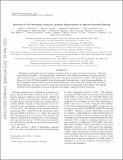| dc.contributor.author | McGuire, Brett A | |
| dc.contributor.author | Loomis, Ryan A | |
| dc.contributor.author | Burkhardt, Andrew M | |
| dc.contributor.author | Lee, Kin Long Kelvin | |
| dc.contributor.author | Shingledecker, Christopher N | |
| dc.contributor.author | Charnley, Steven B | |
| dc.contributor.author | Cooke, Ilsa R | |
| dc.contributor.author | Cordiner, Martin A | |
| dc.contributor.author | Herbst, Eric | |
| dc.contributor.author | Kalenskii, Sergei | |
| dc.contributor.author | Siebert, Mark A | |
| dc.contributor.author | Willis, Eric R | |
| dc.contributor.author | Xue, Ci | |
| dc.contributor.author | Remijan, Anthony J | |
| dc.contributor.author | McCarthy, Michael C | |
| dc.date.accessioned | 2022-03-10T12:38:29Z | |
| dc.date.available | 2022-03-10T12:38:29Z | |
| dc.date.issued | 2021 | |
| dc.identifier.uri | https://hdl.handle.net/1721.1/141106 | |
| dc.description.abstract | Unidentified infrared emission bands are ubiquitous in many astronomical sources. These bands are widely, if not unanimously, attributed to collective emissions from polycyclic aromatic hydrocarbon (PAH) molecules, yet no single species of this class has been identified in space. Using spectral matched filtering of radio data from the Green Bank Telescope, we detected two nitrile-group–functionalized PAHs, 1- and 2-cyanonaphthalene, in the interstellar medium. Both bicyclic ring molecules were observed in the TMC-1 molecular cloud. In this paper, we discuss potential in situ gas-phase PAH formation pathways from smaller organic precursor molecules. | en_US |
| dc.language.iso | en | |
| dc.publisher | American Association for the Advancement of Science (AAAS) | en_US |
| dc.relation.isversionof | 10.1126/SCIENCE.ABB7535 | en_US |
| dc.rights | Creative Commons Attribution-Noncommercial-Share Alike | en_US |
| dc.rights.uri | http://creativecommons.org/licenses/by-nc-sa/4.0/ | en_US |
| dc.source | arXiv | en_US |
| dc.title | Detection of two interstellar polycyclic aromatic hydrocarbons via spectral matched filtering | en_US |
| dc.type | Article | en_US |
| dc.identifier.citation | McGuire, Brett A, Loomis, Ryan A, Burkhardt, Andrew M, Lee, Kin Long Kelvin, Shingledecker, Christopher N et al. 2021. "Detection of two interstellar polycyclic aromatic hydrocarbons via spectral matched filtering." Science, 371 (6535). | |
| dc.contributor.department | Massachusetts Institute of Technology. Department of Chemistry | |
| dc.relation.journal | Science | en_US |
| dc.eprint.version | Author's final manuscript | en_US |
| dc.type.uri | http://purl.org/eprint/type/JournalArticle | en_US |
| eprint.status | http://purl.org/eprint/status/PeerReviewed | en_US |
| dc.date.updated | 2022-03-09T19:24:45Z | |
| dspace.orderedauthors | McGuire, BA; Loomis, RA; Burkhardt, AM; Lee, KLK; Shingledecker, CN; Charnley, SB; Cooke, IR; Cordiner, MA; Herbst, E; Kalenskii, S; Siebert, MA; Willis, ER; Xue, C; Remijan, AJ; McCarthy, MC | en_US |
| dspace.date.submission | 2022-03-09T19:24:49Z | |
| mit.journal.volume | 371 | en_US |
| mit.journal.issue | 6535 | en_US |
| mit.license | OPEN_ACCESS_POLICY | |
| mit.metadata.status | Authority Work and Publication Information Needed | en_US |
